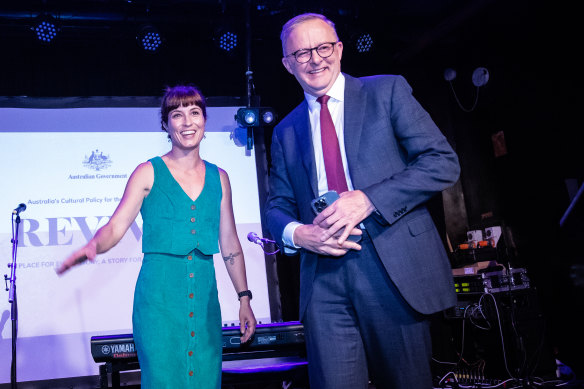The looming political battle over the future of streaming

After years of back and forth about whether there should be local content obligations on international streaming giants like Netflix, Labor’s National Cultural Policy announcement on Monday drew a line in the sand. There will be, and they will be in place by July 1 next year.
But that doesn’t really signal an end to the debate, merely the start. The form of that regulation will be hashed out over the next six months or so as the various stakeholders – streamers, Foxtel, free-to-air broadcasters, producers – sit down with the government to nut out what that regulation looks like.
Prime Minister Anthony Albanese with Missy Higgins at the launch of Labor’s National Cultural Policy on Monday.Credit:Scott McNaughton
Speaking to this masthead after the launch at St Kilda’s Esplanade Hotel on Monday, Tony Burke, minister for the arts and for workplace and employment relations, enumerated the questions yet to be answered.
“Do you start at the endpoint percentage or do you ramp up towards it; do you have sub-quotas for children’s, documentary and scripted drama [as apply to the commercial free-to-air broadcasters]; and how do you define what’s in and what’s out, what counts as Australian,” he said.
These are not merely rhetorical questions. While many of the streamers issued statements on Monday saying they “look forward” to participating in the consultation process that lies ahead, the complexity of the task for Burke and communications minister Michelle Rowland is enormous.
Screen Producers Australia wants a 20 per cent levy on the streamers’ Australian revenue (which is in line with quotas in France and Italy), while the streamers insist they are spending plenty already and don’t need quotas at all.
Arts Minister Tony Burke says he wants quotas in place by July 1 next year.Credit:Luis Enrique Ascui
According to figures supplied to the Australian Communications and Media Authority under self-reporting requirements introduced by the previous Coalition government, the big five – Disney+, Amazon Prime Video, Netflix, Stan and Paramount+ – spent $335.1 million in the 2021-22 financial year on 718 commissioned, co-commissioned or acquired “Australian programs”. Much of that is cheap, older content to populate their libraries, though. New commissions or co-commissions accounted for 55 titles, at a cost of $253.7 million.
The value of drama production as a whole last year, meanwhile, was $2.29 billion. The sector is already at bursting point, many think. It can be so much bigger, others insist.
The questions are many and interlocking. Should Foxtel, which is transitioning from cable and satellite operator to streamer, be subject to the new legislation? How do you calculate Amazon’s income when Prime is primarily a delivery service for shopping? What about bundled Apple subscriptions? The fact that Stan and Paramount+ are part of media companies with free-to-air services that are already subject to content requirements?
And even once a workable framework and figure emerge, the bill will then have to go to Parliament, where Labor will almost certainly need the support of the Greens to pass it. Sarah Hanson-Young on Monday reaffirmed her position: “The quotas should be fixed at 20 per cent of earnings, with a sub-quota of 20 per cent for children’s television.”
In its response on Monday, Netflix made its position clear, too. “We don’t oppose regulation, but we do want it to be sustainable, equitable and evidence-based.”
The line in the sand has been drawn. Now the real battle can begin.
Email the author at [email protected], or follow him on Facebook at karlquinnjournalist and on Twitter @karlkwin.
Find out the next TV, streaming series and movies to add to your must-sees. Get The Watchlist delivered every Thursday.
Most Viewed in Culture
From our partners
Source: Read Full Article

